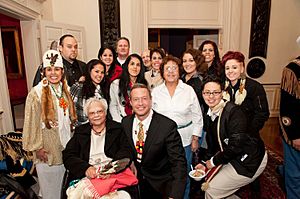We-Sorts facts for kids

We-Sorts (sometimes spelled Wesorts) is a name used for a group of Native Americans in Maryland. These individuals are mostly from the Piscataway tribe. Some people consider the name "We-Sorts" to be offensive, and younger generations rarely use it today. The Piscataway tribe was very powerful when Europeans first arrived in America.
Many people with last names like Proctor, Newman, Wright, Savoy, Queen, Butler, Thompson, Swann, Gray, and Harley say they have Native American heritage. Many of these families have a mixed background, including African American, White, and Native American ancestors. Some members of the Piscataway groups now feel that the name "Wesort" is disrespectful. However, on the 2000 United States Census, some people chose "Wesort" to describe their race.
Discovering the Past
In the early 1930s, a farmer named Alice Ferguson noticed that people were finding small, old items in her fields. She decided to start digging herself. Between 1935 and 1939, she found at least five large burial sites. These sites held the 300-year-old remains of about 500 Piscataway people.
Over the years, Alice Ferguson gave most of these remains, the bones from about 467 individuals, to the Smithsonian Institution. The remaining parts of 36 individuals were later identified as belonging to Piscataway people. Alice and Henry Ferguson also wrote a book called The Piscataway Indians of Southern Maryland, which was published in 1960. State officials in Maryland believe that most of the roughly 25,000 Native Americans living in Maryland today are Piscataway.
We-Sorts in Stories
Wayne Karlin's novel The Wished For Country, published in 2002, tells the story of how the We-Sorts people came to be. It explores their challenges as a multicultural group during the early days of Maryland's first European settlement at St. Mary's City. The Los Angeles Times newspaper reviewed the book, saying it helped bring to life the history of "common people" and their exciting world.

